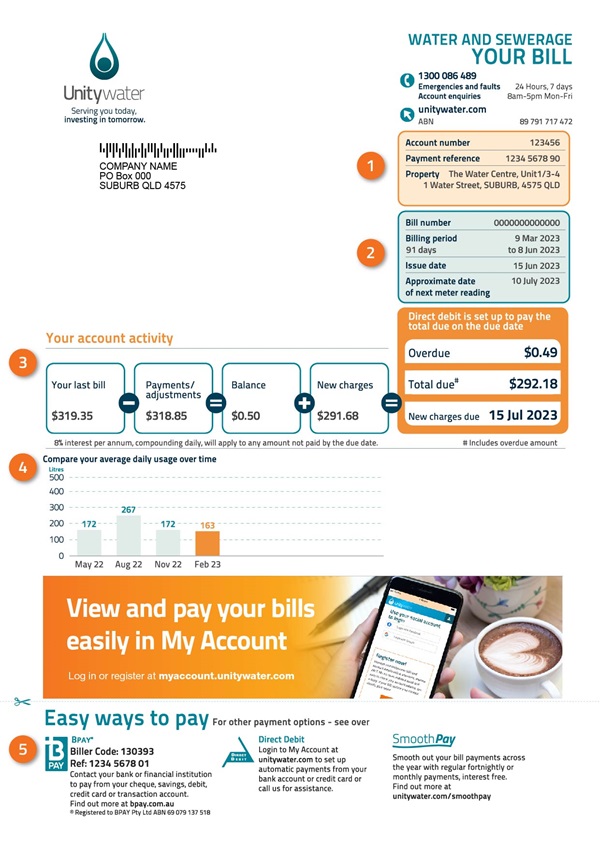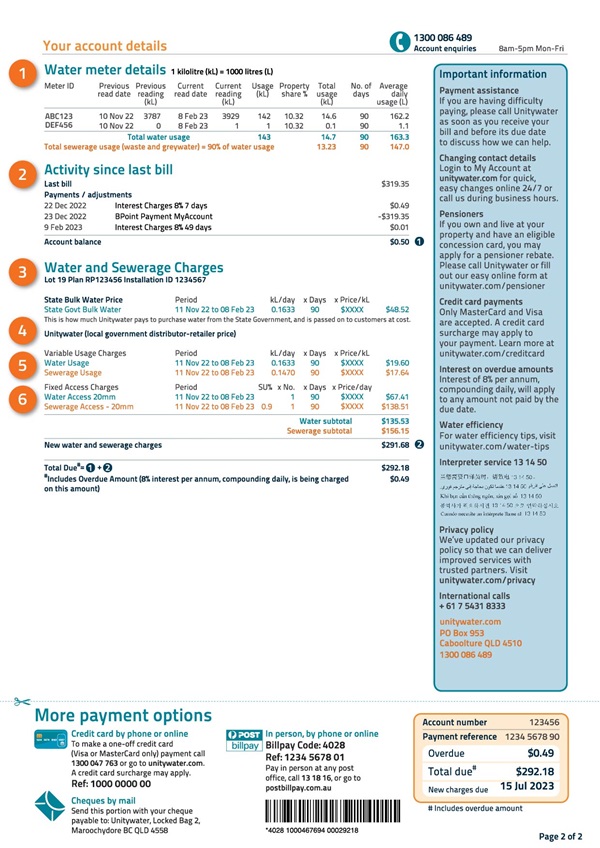For business customers who have been receiving regular quarterly bills
Our bill guide is designed to help you understand your bill and monitor your water usage.
Page 1 of your quarterly bill

Your guide to reading page 1 of your quarterly bill
Account Number
Use this number to register for My Account and keep it handy if you need to contact us for assistance.
Payment reference
Use this when paying your bill – if you have more than one property, each property will have its own reference number.
Property
This is the property address that is being billed. This may be different to your postal address.
Need to change your postal address?
Bill number
This is a unique number that helps you identify each individual quarterly bill we send you.Billing period
This is the time period we are charging you for on this bill. For customers with a water meter, this is the period of time between your last two meter reads.
The days shown is the number of days you are being charged for on each bill.
Approximate date of next meter reading
Please make sure your water meter is clear and accessible around this time so we can read it.
Learn how to read your water meter so you can:
- take your own reading and compare it to the the reading printed on your meter reading notice (PDF 169KB) to make sure these numbers are the same (this helps to ensure the meter reader has recorded your meter reading correctly)
- be proactive and check for any leaks early.
Your account activity
This is a summary of the amount charged on your last bill, any payments or adjustments made since then, plus the new charges for this billing period and the total amount due for payment.
Payments and adjustments are detailed on page 2 of your bill.
Total due and due date
See at a glance what you owe and when it is due.
Compare your average daily usage over time
This graph allows you to compare your water usage over time by showing your average daily usage for the last four quarters. You can compare your water usage for the current billing period (shown in orange) with previous bills (shown in blue).
View our water efficiency tips to help you reduce your water use.
Easy ways to pay
We’ve listed some of the easiest ways to pay on the front page for your convenience. Other payment options are listed on Page 2.
Find out more about our bill payment options.
Page 2 of your quarterly bill

Your guide to reading page 2 of your quarterly bill
Previous read date and previous reading
This shows the date and total amount of water in kilolitres (kL) recorded for this property at the start of this billing period.
Current read date and current reading
This shows the date and total amount of water in kilolitres (kL) recorded for this property at the end of this billing period. Billing periods are usually 90 days but may vary by several days either way.
Usage (kL)
This is the total amount of water in kilolitres (kL) used during this billing period and is the 'Current reading (kL)' minus the 'Previous reading (kL)'. There is a record for each meter.
Average daily usage (L)
Average daily usage in litres (L) is calculated by dividing your total usage by the number of days in the billing period.
Please note: 1 kilolitre (kL) = 1000 litres (L)
Property share %
If you have purchased a unit in a complex, you may see 'Property share %' on your bill to show the lot entitlement for the unit (the percentage of total water usage a unit has to pay according to the Body Corporate agreement). The total usage will represent the percentage in kilolitres for the unit.
Fire meters
Dedicated fire meters may be listed in the water meter details to show consumption.
Activity since last bill
This includes the amount of your last bill minus any payments and/or adjustments made since then, including any direct debit payments.Account balance
This is the balance of your account prior to the charges for this billing period being applied.Lot / Plan / Installation ID
Non-residential properties have a Lot and Plan number for each legal parcel of land that makes up the property. The Installation ID is Unitywater’s unique identifier for each lot, or parcel of land. Most non-residential properties only have one; however, if the property is made up of multiple lots, there will be a different Lot, Plan and Installation ID number for each one.State bulk water price
This is the amount the State Government charges Unitywater to purchase water to supply to our customers. Unitywater is legally required to pass this cost on in full to our customers, and all revenue raised from bulk water charges is passed back to the State Government. Bulk water is charged per kilolitre of water used.
More information on pricing for your region.
Bulk Water Fire Allowance
Customers are allowed 1 kilolitre (kL) per quarter of water to pass through a fire meter for testing purposes free of charge and then will pay for all excess water after that. The allowance is up to 11 litres (L) per day.
Unitywater (local government distributor-retailer price)
Unitywater’s charges for water and sewerage usage and fixed water and sewerage access. See Variable Water Usage Charges and Fixed Access Charges for more details.
More information on pricing for your region
Water usage charge
Water usage is a variable charge because it is based on the amount of water that is consumed at your property, and is charged per kilolitre of water used.
Sewerage usage charge
Sewerage usage is a variable charge because it is based on the amount of water used at your property. As there is no meter to measure the amount of sewage, it is calculated based on water usage multiplied by a sewerage usage percentage based on the property land use type.
Sewerage usage may differ depending on industry type and water usage. A property sewerage usage percentage can be reviewed for a fee.
Please note : 1 kilolitre (kL) = 1000 litres (L)
More information on pricing for your region
Fixed access charges
These charges are for your property having access (connected or unconnected) to the water and sewerage network. They pay for building, maintaining and replacing water supply and sewerage infrastructure, including pipes, pumps and sewage treatment plants. If you have purchased vacant land in an area that is serviced by the water and/or sewerage network, you will be billed for fixed access charges for that property.
Access fees are fixed, annual fees charged at a daily price for the number of days in your billing period.
